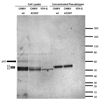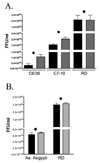Characterization of Chikungunya pseudotyped viruses: Identification of refractory cell lines and demonstration of cellular tropism differences mediated by mutations in E1 glycoprotein
- PMID: 19692105
- PMCID: PMC2760448
- DOI: 10.1016/j.virol.2009.07.013
Characterization of Chikungunya pseudotyped viruses: Identification of refractory cell lines and demonstration of cellular tropism differences mediated by mutations in E1 glycoprotein
Abstract
Chikungunya virus (CHIKV) is an alphavirus responsible for a number of large outbreaks. Here we describe the efficient incorporation of CHIKV envelope glycoproteins into lentiviral and rhabdoviral particles. Vectors pseudotyped with CHIKV envelope proteins efficiently transduced many cell types from different species. However, hematopoietic cell types were either partially or completely refractory. A mutation in E1 (A226V) has been linked with expansion of tropism for mosquito species, although differences in in vitro infection of mosquito cell lines have not been noted. However, pseudovirion infectivity assays detected subtle differences in infection of mosquito cells, suggesting an explanation for the changes in mosquito tropism. The presence of C-type lectins increased CHIKV pseudotyped vector infectivity, but not infection of refractory cells, suggesting that they act as attachment factors rather than primary receptors. CHIKV pseudotypes will serve as an important tool for the study of neutralizing antibodies and the analysis of envelope glycoprotein functions.
Figures






Similar articles
-
Changes in the chikungunya virus E1 glycoprotein domain II and hinge influence E2 conformation, infectivity, and virus-receptor interactions.J Virol. 2024 Jul 23;98(7):e0067924. doi: 10.1128/jvi.00679-24. Epub 2024 Jun 6. J Virol. 2024. PMID: 38842335 Free PMC article.
-
Selective transduction of astrocytic and neuronal CNS subpopulations by lentiviral vectors pseudotyped with Chikungunya virus envelope.Biomaterials. 2017 Apr;123:1-14. doi: 10.1016/j.biomaterials.2017.01.023. Epub 2017 Jan 23. Biomaterials. 2017. PMID: 28152379
-
Emerging Chikungunya Virus Variants at the E1-E1 Interglycoprotein Spike Interface Impact Virus Attachment and Inflammation.J Virol. 2022 Feb 23;96(4):e0158621. doi: 10.1128/JVI.01586-21. Epub 2021 Dec 22. J Virol. 2022. PMID: 34935436 Free PMC article.
-
Early Events in Chikungunya Virus Infection-From Virus Cell Binding to Membrane Fusion.Viruses. 2015 Jul 7;7(7):3647-74. doi: 10.3390/v7072792. Viruses. 2015. PMID: 26198242 Free PMC article. Review.
-
Chikungunya virus and its mosquito vectors.Vector Borne Zoonotic Dis. 2015 Apr;15(4):231-40. doi: 10.1089/vbz.2014.1745. Epub 2015 Feb 12. Vector Borne Zoonotic Dis. 2015. PMID: 25674945 Review.
Cited by
-
The viral capping enzyme nsP1: a novel target for the inhibition of chikungunya virus infection.Sci Rep. 2016 Aug 22;6:31819. doi: 10.1038/srep31819. Sci Rep. 2016. PMID: 27545976 Free PMC article.
-
A single asparagine-linked glycosylation site of the severe acute respiratory syndrome coronavirus spike glycoprotein facilitates inhibition by mannose-binding lectin through multiple mechanisms.J Virol. 2010 Sep;84(17):8753-64. doi: 10.1128/JVI.00554-10. Epub 2010 Jun 23. J Virol. 2010. PMID: 20573835 Free PMC article.
-
A neutralization assay for chikungunya virus infections in a multiplex format.J Virol Methods. 2014 Jun;201:7-12. doi: 10.1016/j.jviromet.2014.02.001. Epub 2014 Feb 16. J Virol Methods. 2014. PMID: 24552952 Free PMC article.
-
Probing the antigenicity of hepatitis C virus envelope glycoprotein complex by high-throughput mutagenesis.PLoS Pathog. 2017 Dec 18;13(12):e1006735. doi: 10.1371/journal.ppat.1006735. eCollection 2017 Dec. PLoS Pathog. 2017. PMID: 29253863 Free PMC article.
-
Development of an automated plaque-counting program for the quantification of the Chikungunya virus.Sci Rep. 2025 Apr 11;15(1):12429. doi: 10.1038/s41598-025-97590-3. Sci Rep. 2025. PMID: 40217093 Free PMC article.
References
-
- Anon 5 ed. Washigton: US Centers for Disease Control and Prevention, Office of Health and Safety (CDC-OHS); 2007. Biosafety in Microbiological and Biomedical Laboratories.
-
- Ahn A, Schoepp RJ, Sternberg D, Kielian M. Growth and stability of a cholesterol-independent Semliki Forest virus mutant in mosquitoes. Virology. 1999;262(2):452–456. - PubMed
-
- Bodenmann P, Genton B. Chikungunya: an epidemic in real time. Lancet. 2006;368(9531):258. - PubMed
Publication types
MeSH terms
Substances
Grants and funding
LinkOut - more resources
Full Text Sources
Medical

